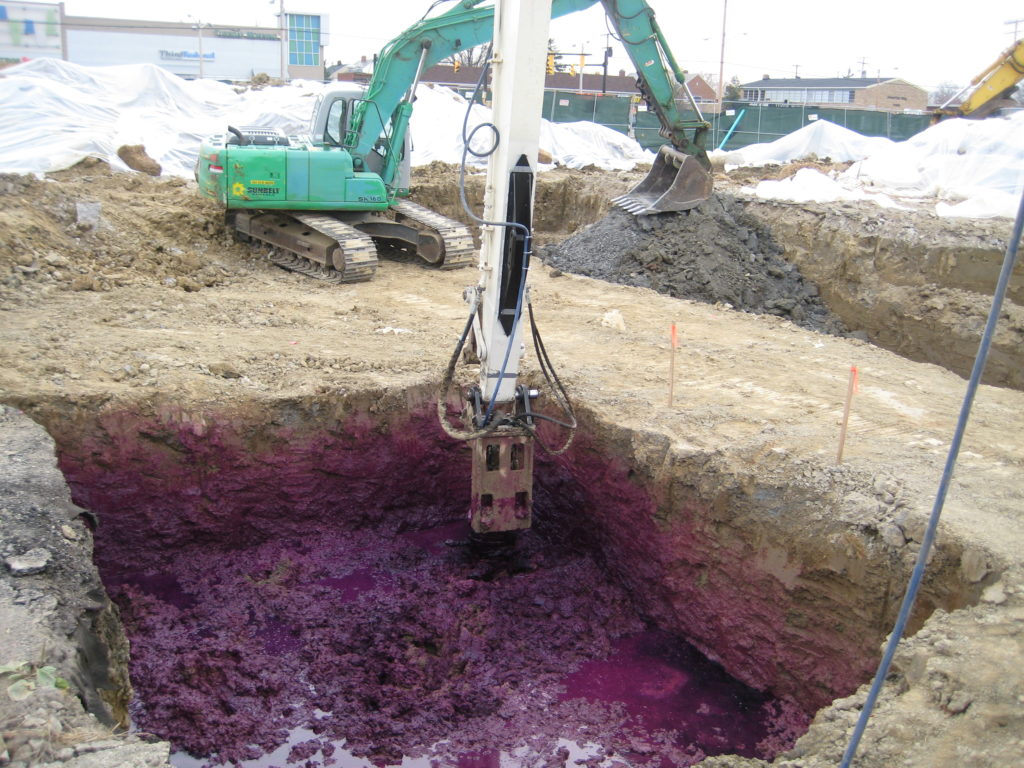
In-situ remediation is an emerging technology that utilizes various methods to remediate soil and groundwater in place or on the site, thus reducing costs and liabilities associated with removal, transportation, and off-site disposal at a licensed facility. Soil and groundwater contaminated with hazardous substances and or petroleum products can be remediated in place or within a treatment cell on site using microbes, surfactants, and non-toxic surfactants and nutrients.
Three key purposes of In-situ remediation:
- In-situ mixing/treatment significantly reduces overall project costs.
- In-situ mixing/treatment is fast-acting.
- In-situ mixing/treatment prevents the generation of hazardous waste.
Depending on cleanup standards and site framework, treated soil either can remain on site or can be removed for disposal as non-hazardous waste. In either case, the three purposes listed above are achieved on each and every site where in-situ mixing/treatment is put to use.
In-situ Remediation Technologies Used:
In-situ Surface Spill Microbial and Chemical Treatment
View in-situ soil remediation using microbial enzyme to treat soil impacted from a crude oil spill
 Physical/chemical treatment uses the physical and/or chemical properties of the contaminants or of the contaminated medium in concert with solutions containing micro-organisms, non-toxic surfactants and nutrients to destroy, separate, or contain the contamination. In the physical processes the phase transfer of pollutants is induced. In the chemical processes the chemical structure (and then the behavior) of the pollutants is changed by means of chemical reactions to produce less toxic or better separable compounds from the soil and groundwater matrices.
Physical/chemical treatment uses the physical and/or chemical properties of the contaminants or of the contaminated medium in concert with solutions containing micro-organisms, non-toxic surfactants and nutrients to destroy, separate, or contain the contamination. In the physical processes the phase transfer of pollutants is induced. In the chemical processes the chemical structure (and then the behavior) of the pollutants is changed by means of chemical reactions to produce less toxic or better separable compounds from the soil and groundwater matrices.
In-situ Surfactants and Microbial Underground Fuel and Chemical Tank Pit Flushing
In-situ surfactant flushing has been used at NAPL- contaminated sites to demonstrate the capability of in situ surfactant flushing for cleaning-up the contaminated “hot” source zone. In-situ soil washing and tank pit flushing is performed using injection and extraction wells to circulate microbial and compound release chemicals within the affected zones, thus expediting recovery of toxic chemicals directly from the source of the pollution.
In-Situ Chemical Oxidant Injection- Subsurface Soil and Groundwater
In-situ chemical oxidation (ISCO) is the most rapidly growing remedial technology applied at EPA hazardous waste sites. ISCO involves the introduction of a chemical oxidant into the subsurface for the purpose of transforming groundwater or soil contaminants into less harmful chemical species. ISCO results in the transformation of a wide range of environmental contaminants, enhances mass transfer, and is being used at both old sites and newly discovered hazardous waste sites. ISCO is specifically used to reduce contaminant mass and concentrations in soil and groundwater, contaminant mass flux from source areas to downgradient pump-and-treat systems, and to reduce anticipated cleanup times required for natural attenuation and other remedial options.
Most commonly used oxidants:
- Permanganate (MnO4-)
- Fenton’s (hydrogen peroxide [H2O2] and Ferrous iron [Fe+2]) or catalyzed hydrogen peroxide (CHP)
- Ozone (O3)
- Persulfate (S2O82-)
The two most commonly used forms of injected oxidants are permanganate and Fenton’s.
